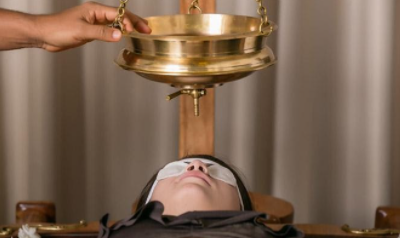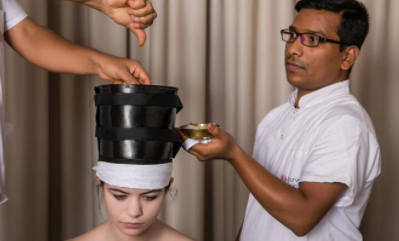The Ayurvedic approach is a whole healing system based on the ancient Vedic knowledge of the human body. Unique in its technique, Ayurvedic healing affects the whole body, not a single organ or organ. system.
The Ayurvedic approach to each patient is based on his constitution (prakriti) . The constitution is determined by the Ayurvedic doctor using the method of pulse diagnosis.
Based on it, the doctor selects medications and treatment procedures specifically for the individual. The main procedures in Ayurvedic treatment are different types of massages with oils and medicinal plants, oil baths and cleansing procedures.
It is important to understand that Ayurvedic treatment is aimed primarily at restoring balance in the body, at eliminating the root cause of the disease, not at treating its symptoms.
In addition to the procedures, Ayurveda focuses on what a person eats during the treatment . A balanced diet is associated with all six flavors – sweet, salty, bitter, sour, astringent and spicy. & Nbsp ;
Ayurvedic recipes are quite simple, but the dishes are delicious and nutritious. Ayurveda proves that everyday food can be our medicine by stimulating digestion through the spices and herbs used.
Differences with traditional medicine

A holistic approach to human health
Modern medicine, as a synthetic system of theoretical and practical measures for diagnosis, treatment, preservation and strengthening of health, focuses on the natural science concept of man as a biological object.
This allows it to effectively eliminate the symptoms of acute diseases, to act in situations of mortal threat to human life (trauma, burns, injuries, poisonings, respiratory arrest, cardiac arrest, etc.).
Ayurveda, as a holistic science, encompasses the whole person in its physical and metaphysical aspects , as a & quot; microcosm & quot ;, reflecting the entire surrounding universe – & quot; macrocosm & quot ;, in the form of seven bodies: physical ( anatomy and physiology), etheric (energy), astral (feelings), mental (thoughts), causal (karma), budial (soul), atmanic (spirit).
The main difference in the methodological approaches to human health
There is a fundamental difference in methodological approaches to human health between Ayurveda and modern medicine.

Ayurveda focuses on the basic, deep, essential, primary aspects of health. And modern medicine reaches heights in the knowledge of no less important, but secondary, derivative, symptomatic aspects of health.
Individual approach to the patient, taking into account his constitutional characteristics
Ayurveda proclaims the uniqueness of each individual, recognizing that he has individual psycho-physiological characteristics.
They can be:
- genetics
- appearance
- structural features of the body and organs
- metabolic characteristics
- immunity
- force
- endurance
- temperament
- emotionality
- thinking stereotypes and much more
All these individual psycho-physiological characteristics are described by the Ayurvedic constitution of man (Prakriti) , the current ratio of doshas (Vikriti) and his mental constitution (manasa-dosha).
Priority of prevention over treatment
A healthy lifestyle is an effective and inexpensive prevention of the onset and development of serious diseases. The disease is easier to prevent than to cure.
This is recognized by all medical systems:
- modern medicine
- traditional Chinese medicine
- traditional Tibetan medicine and others
But it is in Ayurveda the principle of disease prevention through a healthy lifestyle that has received the greatest development, has survived to this day and is always present in the recommendations of a specialist.
Diagnosis of diseases at early (preclinical) stages
The success of the treatment largely depends on the correct diagnosis. Modern medicine has come a long way in improving the diagnosis: from the wooden ear canal – stethoscope to modern ultrasound, MRI, CT and other high-tech diagnostic methods.
All this helps the modern doctor to make an accurate diagnosis and prescribe adequate treatment.
Ayurveda has been perfecting its specific methods of examining patients for thousands of years:
- Patient interview
- Patient Examination
- Pulse diagnostics
- language diagnostics (linguodiagnostics)
- nail diagnostics
- eye diagnostics
These Ayurvedic diagnostic methods seem simple at first glance. In fact, they require long-term training and ongoing training from a specialist.
Ayurvedic diagnostic methods allow to detect the first signs of disorders and to determine the beginning of the development of the pathological process in the preclinical stage, long before the onset of symptoms of the disease , and a person still still considered healthy from the point of view of modern medicine.
This makes it possible to eliminate the identified deviations with simple preventive measures.
Naturopathic healing methods
According to Ayurveda, everything in this world is medicine if applied correctly – to a particular person, under specific circumstances, over a period of time. But vice versa – everything in this world is poison if is being used incorrectly.
Thus, it can be concluded that modern medicine and Ayurveda have similarities . The common focus of both medical systems is man. Their common goal is to achieve human health , physical, mental , as well as mental well-being.
At the same time, modern medicine and Ayurveda have differences.
In general, they can be summarized as follows:
- Modern medicine has focused its attention and efforts on the physical aspects of human health.
- Ayurveda views man in all his complex multidimensionality as an isolated part (& bdquo; microcosm & ldquo;) of the infinite world of consciousness and matter (& bdquo; macrocosm & ldquo;).
The similarities and differences between modern medicine and Ayurveda allow us not to oppose them and not to consider them as alternative, mutually exclusive disciplines.
That is why they should be recognized as complementary medical systems.
Can Ayurveda be considered a cure for all diseases?
Unlike classical medicine, which is effective in treating various injuries and acute diseases requiring surgical intervention, ancient Indian medicine is aimed primarily at supporting the natural normalization of all dysfunctions of the human body and maintaining a healthy tone.
According to the Ayurvedic system of knowledge, a person gets sick when the balance of the three doshas is disturbed in the body – Vata (air, ether), Pita (fire) and Kapha (mucus, water).
Ayurveda medicine aims to help restore the balanced state of the whole body, by determining an appropriate nutritional system, using medicinal herbs and other healing organic components – aromatherapy, various types of health massage and yoga, music and meditative practices.
In general, Ayurveda is primarily looking for the root causes of various diseases & ndash; guilt, uncontrollable fear, or unresolved conflicts.
This is how it heals:
- migraine, hypertension, atherosclerosis, rheumatoid arthritis, hepatosis, liver and pancreas problems, decompensated conditions
- gynecological disorders, gastrointestinal diseases, anemia, diabetes, neurological disorders, etc.
- Headache, insomnia, impotence, depression, insomnia, anemia, asthma, skin diseases
In order to achieve the health of the whole human body, Ayurveda practitioners call for and help to achieve both physiological and mental balance, harmony of thoughts.
Photos ayurvedabansko.bg




0 Comments